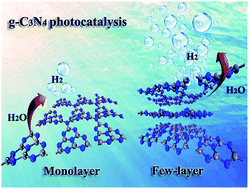Photocatalytic performance of few-layer graphitic C3N4: enhanced by interlayer coupling†
Abstract
For atomically thin two-dimensional materials, van der Waals interlayer coupling is a crucial factor to tune or produce novel physicochemical properties. In terms of photocatalysis, however, researching into the interlayer coupling effect is still in its infancy, especially that involving excited state dynamics. Here, by performing many-body perturbation theory and ab initio nonadiabatic molecular dynamics, we find that metal-free few-layer graphitic C3N4 (g-C3N4) possesses a better photocatalytic hydrogen evolution performance due to interlayer coupling compared with ultrathin monolayer g-C3N4. Specifically, few-layer g-C3N4 activates the electronic transition channel around the Fermi level and transforms dark excitation to bright excitation, which broadens the solar light absorption region. Meanwhile, few-layer g-C3N4 can effectively weaken the strong binding energy between nitrogen and hydrogen by means of intralayer charge transfer, and can enhance the activity of hydrogen evolution reactive sites. Furthermore, the interlayer coupling tends to localize photogenerated electrons at the reactive sites, which can provide more active electrons to participate in the catalytic reaction.



 Please wait while we load your content...
Please wait while we load your content...